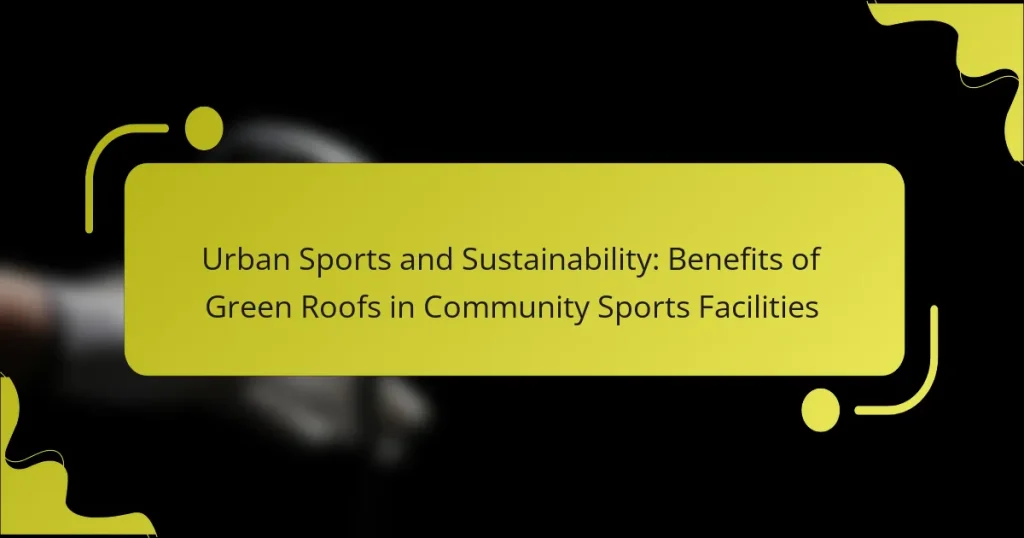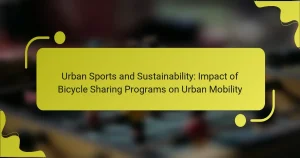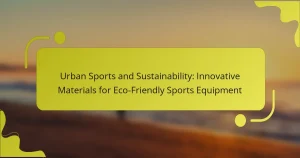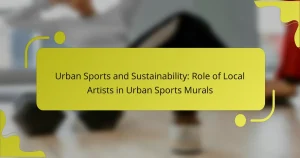Urban sports facilities can greatly benefit from the implementation of green roofs, which enhance air quality and reduce urban heat. These roofs promote biodiversity and provide recreational spaces, fostering community engagement. Effective design and maintenance considerations are crucial for maximizing their impact. Additionally, green roofs offer economic advantages, increase property values, and enhance the aesthetic appeal of sports facilities.
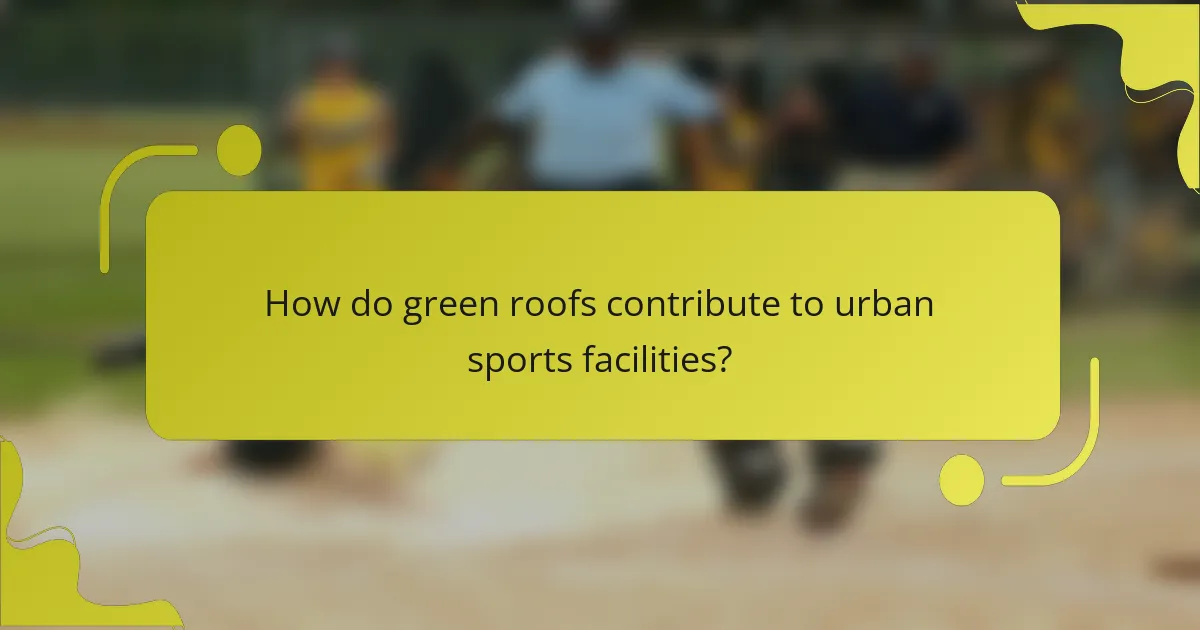
How do green roofs contribute to urban sports facilities?
Green roofs enhance urban sports facilities by improving air quality, reducing heat, and promoting biodiversity. They provide insulation, lowering energy costs, and create recreational spaces. Additionally, green roofs manage stormwater effectively, reducing flooding risks during heavy rainfall. This sustainable design contributes to healthier communities and supports environmental goals.
What are the environmental benefits of green roofs in sports venues?
Green roofs in sports venues provide significant environmental benefits. They enhance biodiversity by creating habitats for various species. Additionally, they improve air quality by filtering pollutants and absorbing carbon dioxide. Green roofs also reduce urban heat, lowering energy costs for cooling. Furthermore, they manage stormwater effectively, reducing runoff and minimizing flooding risks. These benefits contribute to sustainable urban sports facilities.
How do green roofs improve air quality in urban areas?
Green roofs significantly improve air quality in urban areas by filtering pollutants and providing oxygen. They absorb carbon dioxide and trap particulate matter, reducing smog and enhancing overall air clarity. Studies show that green roofs can lower urban temperatures, which helps mitigate the heat island effect, further improving air quality. Additionally, they promote biodiversity, supporting various plant and animal species that contribute to a healthier ecosystem.
What role do green roofs play in stormwater management for sports facilities?
Green roofs significantly enhance stormwater management for sports facilities by absorbing rainfall, reducing runoff, and promoting water retention. They mitigate flooding risks and improve water quality through natural filtration. Additionally, green roofs can lower urban temperatures, which further aids in managing stormwater. Studies indicate that green roofs can retain up to 80% of precipitation during rainfall events, showcasing their effectiveness in urban settings.

Why are green roofs essential for community engagement in urban sports?
Green roofs are essential for community engagement in urban sports as they enhance accessibility, promote environmental awareness, and provide multifunctional spaces. These green spaces foster social interaction, encouraging people to participate in sports and recreational activities. Research indicates that urban sports facilities with green roofs attract more visitors, leading to increased community involvement and healthier lifestyles. Additionally, green roofs improve air quality and reduce urban heat, creating more comfortable environments for outdoor sports.
How do green roofs foster social interaction among athletes and spectators?
Green roofs enhance social interaction among athletes and spectators by creating inviting communal spaces. These green areas promote engagement through shared experiences, fostering a sense of community. Natural elements on the roof encourage relaxation and socializing, benefiting both physical and mental well-being. Studies show that green roofs can increase foot traffic, leading to more interactions during events. Additionally, they serve as unique venues for informal gatherings, enhancing the overall atmosphere of community sports facilities.
What impact do green roofs have on community health and well-being?
Green roofs positively impact community health and well-being by enhancing urban sports facilities. They improve air quality, reduce heat, and increase green space, promoting physical activity. Studies show that access to green spaces can reduce stress and improve mental health. Additionally, green roofs can lower energy costs for facilities, allowing more funds for community sports programs.
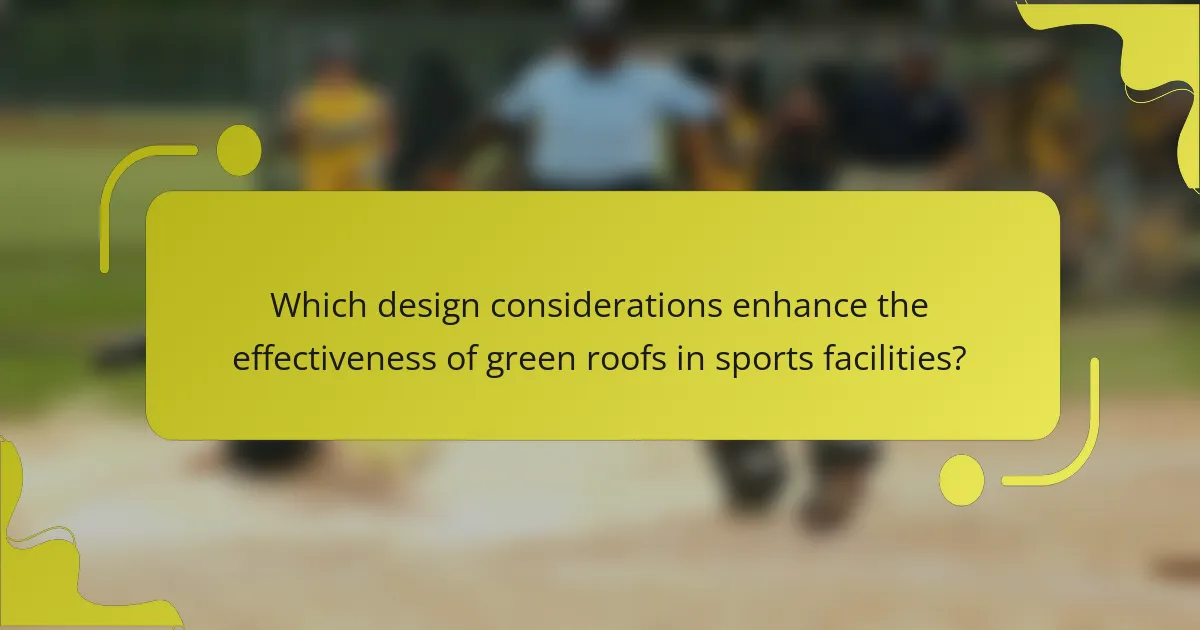
Which design considerations enhance the effectiveness of green roofs in sports facilities?
Design considerations that enhance the effectiveness of green roofs in sports facilities include proper plant selection, irrigation systems, and structural support. Selecting native plants ensures resilience and minimal maintenance. Efficient irrigation systems optimize water usage, while robust structural support accommodates soil depth and weight. These elements contribute to improved insulation, stormwater management, and biodiversity. Green roofs also enhance user experience and community engagement by creating green spaces for relaxation and recreation.
What types of vegetation are most suitable for green roofs in sports contexts?
Sedum species, grasses, and native wildflowers are the most suitable vegetation types for green roofs in sports contexts. Sedum provides drought resistance and low maintenance, while grasses offer durability and resilience. Native wildflowers enhance biodiversity and support local ecosystems. These plants contribute to stormwater management, improved air quality, and aesthetic appeal in community sports facilities.
How does roof structure influence green roof performance in community sports facilities?
Roof structure significantly affects green roof performance in community sports facilities by influencing water retention, insulation, and plant health. A well-designed roof can enhance stormwater management and support diverse vegetation, promoting sustainability. For example, a sloped roof may improve drainage, while a flat roof can allow for more extensive green coverage. Additionally, structural materials impact weight capacity and thermal efficiency, which are crucial for maintaining plant health and energy savings. These factors collectively enhance the ecological benefits of green roofs, such as reducing urban heat and improving air quality.
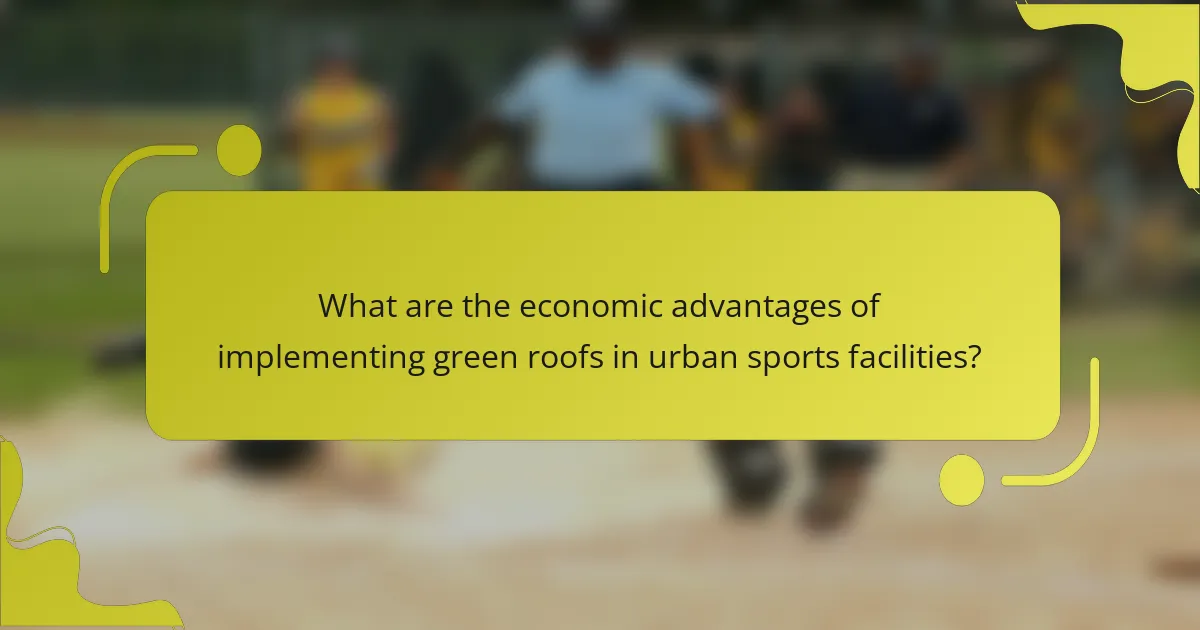
What are the economic advantages of implementing green roofs in urban sports facilities?
Implementing green roofs in urban sports facilities offers significant economic advantages. These roofs reduce energy costs, enhance stormwater management, and increase property values.
Energy savings stem from improved insulation, which lowers heating and cooling expenses. For example, studies show that green roofs can reduce energy consumption by up to 25%.
Stormwater management benefits include reduced runoff and lower infrastructure costs for drainage systems. Green roofs absorb rainwater, decreasing the burden on municipal systems during heavy rainfall.
Additionally, properties with green roofs often see increased market value. Aesthetic appeal and environmental sustainability attract more tenants and users, leading to higher revenues for facilities.
How do green roofs reduce operational costs for sports facilities?
Green roofs significantly reduce operational costs for sports facilities by enhancing energy efficiency and extending roof lifespan. They provide insulation that lowers heating and cooling expenses, leading to substantial savings. Additionally, green roofs manage stormwater effectively, reducing drainage costs and minimizing water bills. Studies show facilities with green roofs can save up to 25% on energy costs annually. The unique attribute of green roofs is their ability to support biodiversity, which can enhance community engagement and increase facility usage.
What funding opportunities exist for green roof projects in community sports?
Funding opportunities for green roof projects in community sports include grants, public-private partnerships, and local government initiatives. Various organizations offer financial support specifically for sustainable infrastructure. For instance, the Environmental Protection Agency provides funding through its Green Infrastructure program. Additionally, community development block grants may be available for enhancing local sports facilities with green roofs. Nonprofits focused on environmental sustainability often have grant programs for such projects as well. Engaging with local businesses for sponsorships can also provide necessary funding while promoting community involvement.
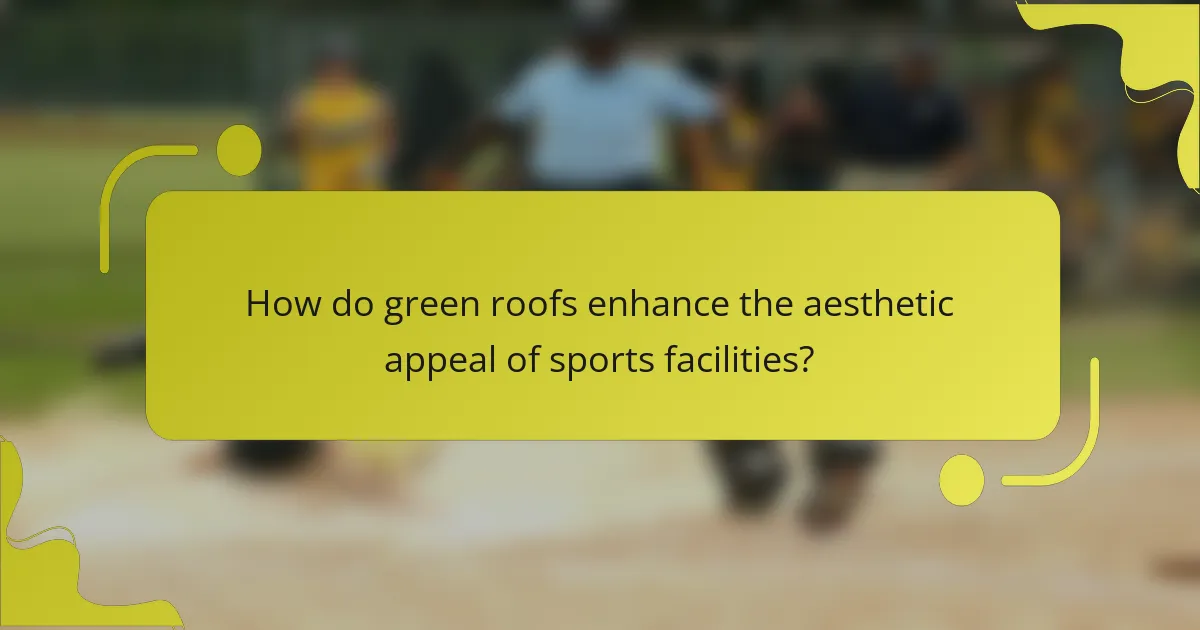
How do green roofs enhance the aesthetic appeal of sports facilities?
Green roofs significantly enhance the aesthetic appeal of sports facilities by integrating nature into urban landscapes. They provide vibrant greenery, improve visual interest, and create inviting spaces for spectators and athletes alike. Additionally, the diverse plant life can contribute to a sense of tranquility, making the environment more enjoyable. The presence of green roofs can also increase community pride and engagement, fostering a stronger connection between the facility and its surroundings.
What design elements can maximize visual impact and functionality?
Incorporating design elements that enhance both visual impact and functionality is essential for green roofs in community sports facilities. Key elements include vibrant plant selections, accessible pathways, and integrated seating areas. These features promote aesthetic appeal and practical use, encouraging community engagement and sustainability. Effective drainage systems and native vegetation also optimize performance and reduce maintenance.
How can green roofs reflect local culture and identity in sports venues?
Green roofs can reflect local culture and identity in sports venues by integrating native plants and community art. These roofs serve as living spaces that promote biodiversity while showcasing local flora. Incorporating cultural symbols and artwork on green roofs fosters community pride and engagement. Additionally, sustainable practices in design resonate with the values of local communities, reinforcing their identity through environmental stewardship.
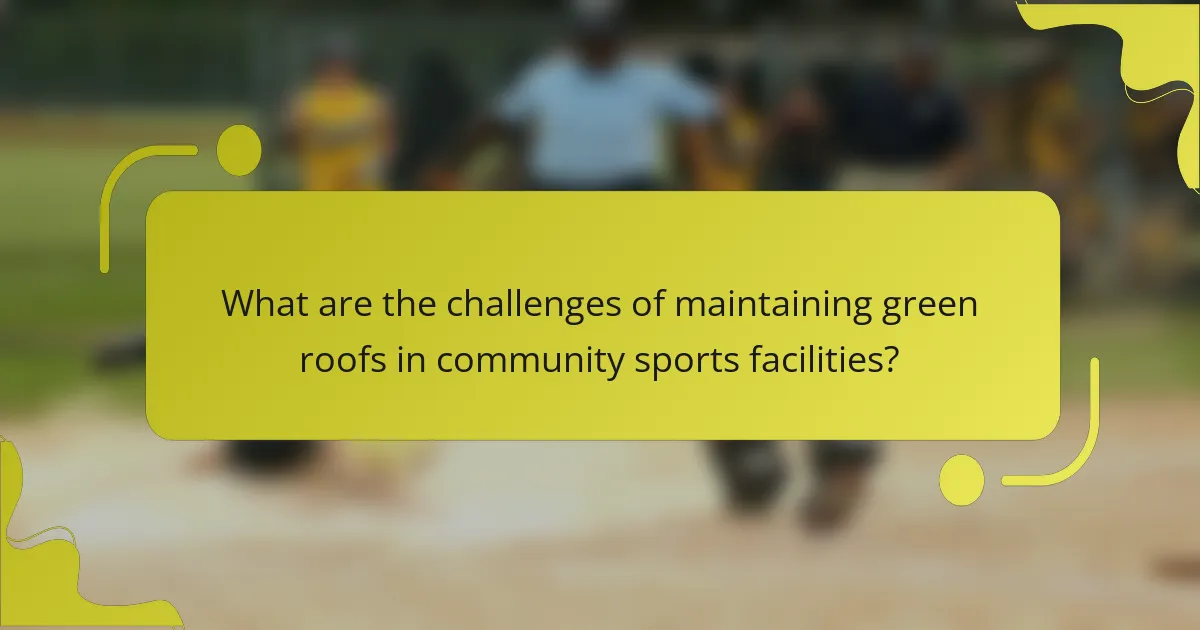
What are the challenges of maintaining green roofs in community sports facilities?
Maintaining green roofs in community sports facilities presents several challenges. These include structural integrity, water drainage, and plant selection. Regular maintenance is needed to prevent damage from extreme weather and ensure plant health. Additionally, community engagement and funding for ongoing upkeep can be difficult to secure.
How can facility managers ensure the longevity of green roofs?
Facility managers can ensure the longevity of green roofs by implementing regular maintenance, selecting appropriate plant species, and ensuring proper drainage. Regular inspections help identify issues like leaks or plant health. Choosing native, drought-resistant plants reduces maintenance needs and supports local biodiversity. Proper drainage systems prevent water accumulation, which can damage the roof structure. Additionally, incorporating a lightweight growing medium can enhance plant health and longevity.
What common maintenance issues should be addressed for optimal performance?
Common maintenance issues for green roofs in community sports facilities include drainage problems, vegetation health, waterproofing integrity, and structural inspections. Addressing these ensures optimal performance and longevity of the green roof system. Regular checks on plant growth and moisture levels help maintain biodiversity and aesthetic appeal. Additionally, monitoring for pests and diseases can prevent larger issues, contributing to environmental sustainability and user satisfaction.
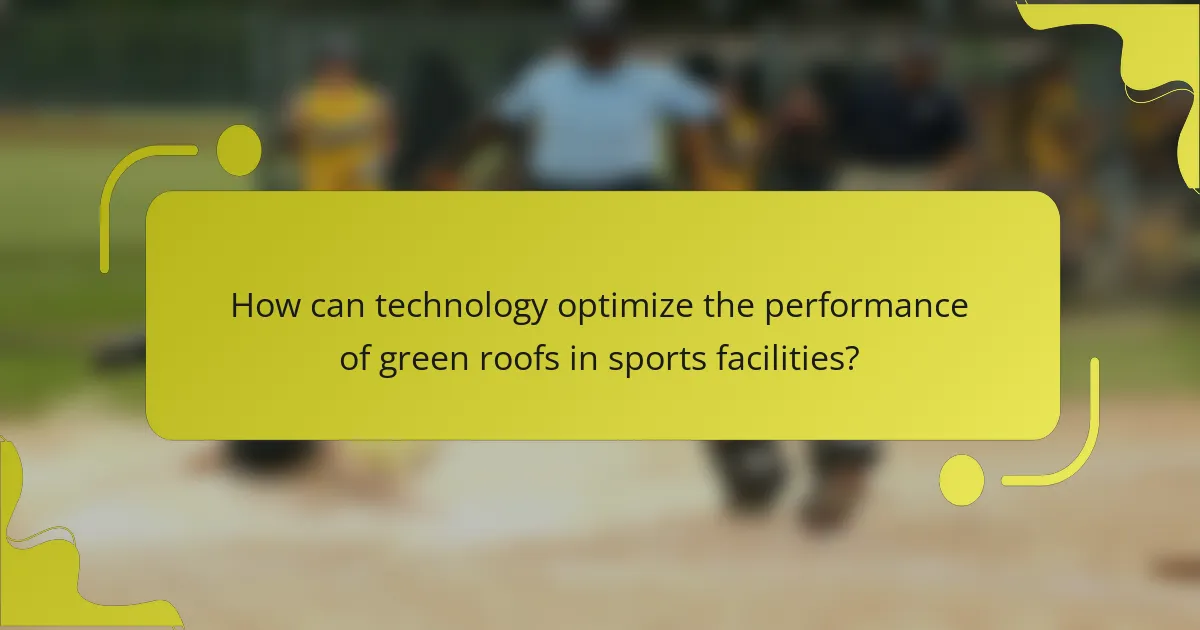
How can technology optimize the performance of green roofs in sports facilities?
Technology can significantly enhance the performance of green roofs in sports facilities by optimizing water management, improving plant health, and increasing energy efficiency. Advanced irrigation systems, such as smart sensors, monitor moisture levels and deliver precise watering. This ensures optimal growth conditions for vegetation, which contributes to better insulation and temperature regulation in facilities. Additionally, using green roof monitoring software allows for real-time assessments of plant health and environmental impact. These technologies collectively enhance the sustainability and functionality of community sports facilities, promoting eco-friendly practices.
What role does irrigation technology play in maintaining green roofs?
Irrigation technology is essential for maintaining green roofs by providing consistent moisture levels. It supports plant health, enhances biodiversity, and improves stormwater management. Automated systems can optimize water usage, reducing waste while ensuring plants thrive. Effective irrigation contributes to the longevity and functionality of green roofs in community sports facilities.
How can smart monitoring systems enhance green roof efficiency?
Smart monitoring systems significantly enhance green roof efficiency by providing real-time data on environmental conditions. These systems optimize water usage, reduce energy consumption, and improve plant health, leading to better performance in community sports facilities. For instance, sensors can monitor moisture levels, ensuring that plants receive adequate irrigation without waste. As a result, green roofs can maintain their cooling effects and biodiversity, contributing to sustainability in urban sports environments.
What best practices should be followed for successful green roof implementation in urban sports?
Successful green roof implementation in urban sports requires careful planning and execution. Key best practices include selecting appropriate plant species that can thrive in local climates, ensuring proper drainage to prevent water accumulation, and integrating the green roof design with existing facility architecture. Regular maintenance is essential to sustain plant health and aesthetic appeal. Collaboration with landscape architects and environmental engineers can enhance the project’s success by incorporating innovative solutions tailored to community needs.
